一 : 七年级语文《世说新语 咏雪》阅读题及答案
《咏雪》课后练习题
1、本文选自南朝宋
2、解释文中的字词。(www.61k.com)
寒雪日内集( ) 讲论文义( ) 即公大兄无奕女( ) ...
俄而 ( )雪骤( ) 欣然( ) 何( )所似( ) .......差( )可拟( ) 未若 ( )柳絮因( )风起 .....
3、翻译:①谢太傅寒雪日内集,与儿女讲论文义。
②撒盐空中差可拟。 ③未若柳絮因风起。
④公大笑乐。 ⑤即公大兄无奕女,左将军王凝之妻也。
4、分析古今词义
①与儿女讲论文义 老人的儿女都在外地 ....
②撒盐空中差可拟 本次活动拟定六月份举行 ..
5、“谢太傅寒雪日内集,与儿女讲论文义”这一句总述了谢太傅家人咏雪的背景,极精炼地交代了时间“ ”、地点“ 、人物“ ”、事件“ ”等要素。文中“寒雪”“内集”“欣然”“大笑”等词语为我们营造了一种 的家庭气氛。
6、文章最后写道:“即公大兄无奕女,左将军王凝之妻也。”你以为作者写上这一句的用意何在?
7、按原文中的句子填写
①交代咏雪背景的句子:
②咏雪的直接原因:
③两个比喻句分别是: ;
④谢道韫对雪的描述是:
⑤补充点明谢道韫身份的句子:
⑥暗示谢太傅赞赏谢道韫才气的句子:
8、谢太傅跟儿女们谈论诗文时,为什么出了一个“白雪纷纷何所似”的咏雪题目?
9、你认为谢太傅究竟满意谁的答案?为什么?
10、用“撒盐空中”和“柳絮因风起”来比拟“白雪纷纷”,你认为哪个更好?为什么?
世说新语 咏雪 七年级语文《世说新语 咏雪》阅读题及答案
《咏雪》习题答案:
1、刘义庆、《世说新语》
2、(家庭聚会)(讲解诗文)(就是)(不久,一会儿)(急速、大)(高兴的样子)
(什么) (像) (大致、差不多)(相比)(不如,比不上)(凭借)
3、一个寒冷的下雪天,谢太傅把家人聚会在一起,跟子侄辈的人讲解诗文。[www.61k.com)
跟把盐撒在空中差不多。
不如比作柳絮凭借风力飘在天空。
太傅高兴得大笑起来。
道韫是太傅大哥谢无奕的女儿、左将军王凝之的妻子。
4、儿女:①子侄辈的人、家中年轻的一代人;②孩子、儿子和女儿。
拟:①相比 ②计划、筹划
5、寒雪日,内,谢太傅与儿女,讲论文义,欢快、轻松、融洽
6、暗示作者赞赏道韫的才气。
7、1)交代咏雪背景的句子:谢太傅寒雪日内集,与儿女讲论文义。
2)咏雪的直接原因:俄儿雪骤。
3)两个比喻句:撒盐空中差可拟,未若柳絮因风起。
4)谢道韫对雪的描述是:未若柳絮因风起。
5)6)补充点明谢道韫身份的句子(暗示谢太傅对谢道韫才气的赞赏):即公大兄无奕女,左将军王凝之妻也。
8、主讲人出题考听众时,天气发生了变化:早先也有雪,但不大,而此刻变成了纷纷扬扬的大雪。这使主讲人感到很高兴,就出了一个“白雪纷纷何所似”的咏雪题目。
9、对兄女的答案满意。因为文章最后一句“即公大兄无奕女,左将军王凝之妻也。”补充点明了谢道韫的身份,暗示了谢太傅对道韫才气的赞赏。
10、“柳絮”一喻好,因为柳絮团状,与雪花相似,而“因风起”写出雪花漫天飞舞之态,給人以想象和美感,比喻生动传神,而且“柳絮”还给人以春天即将到来的温暖的感觉,有深刻的意蕴。
二 : 复习六年级文言文阅读题和答案
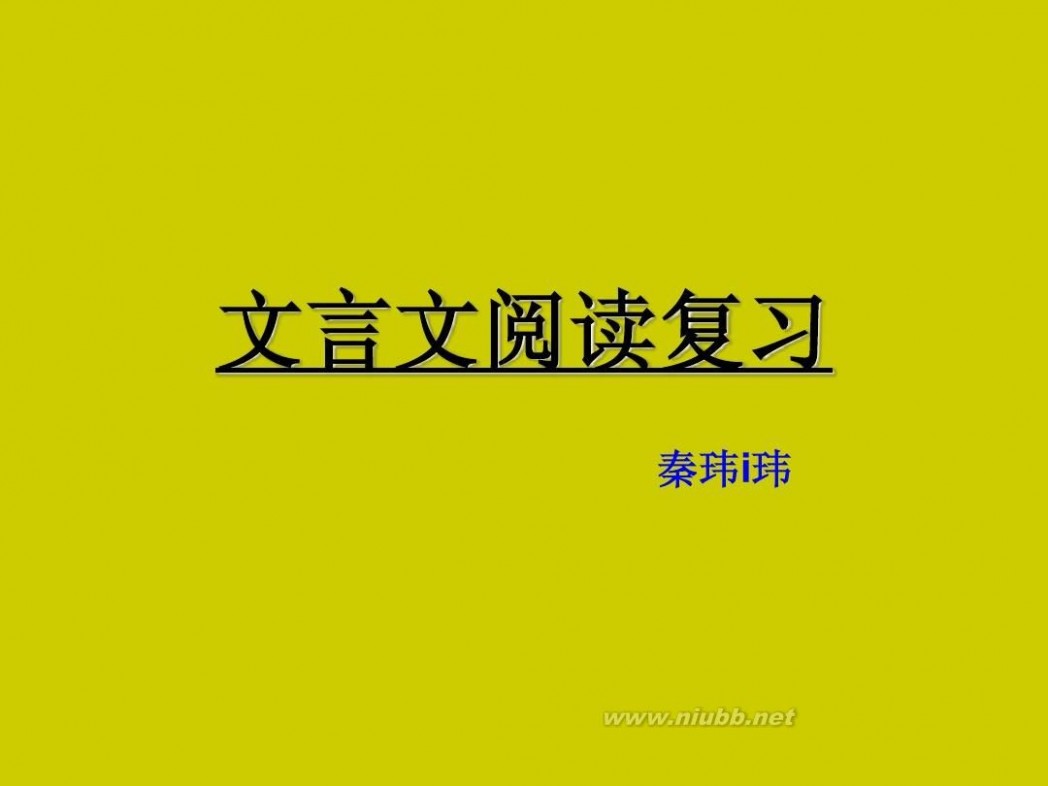
凿壁偷光文言文 复习六年级文言文阅读题和答案
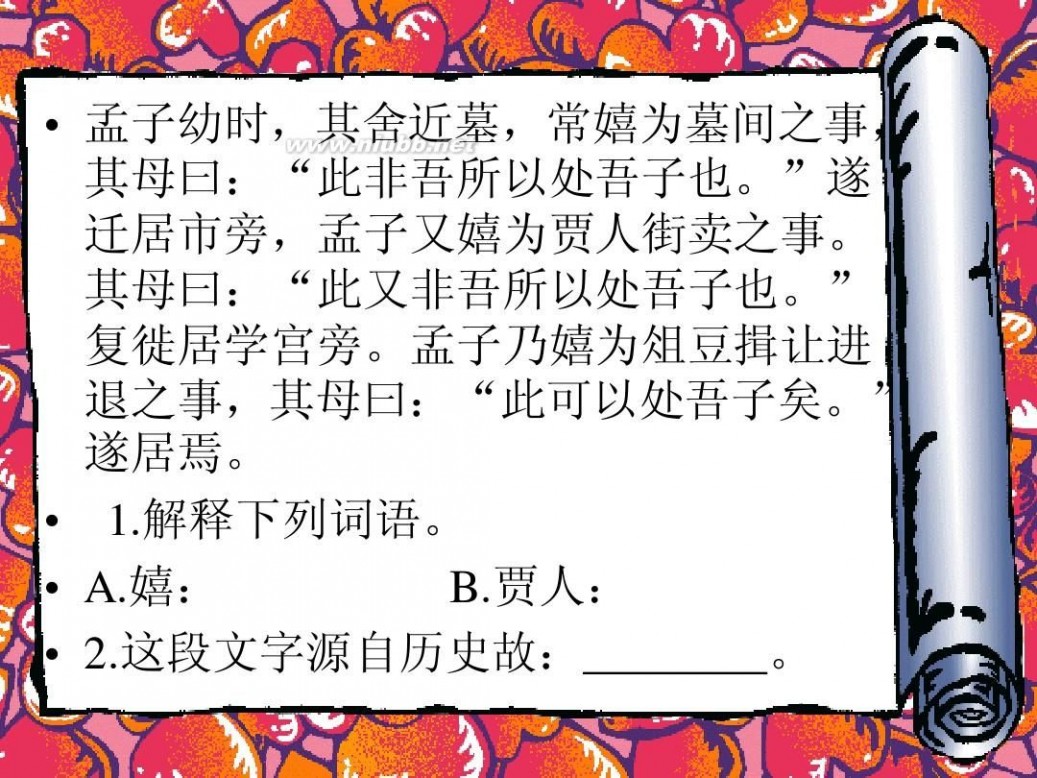
凿壁偷光文言文 复习六年级文言文阅读题和答案

凿壁偷光文言文 复习六年级文言文阅读题和答案
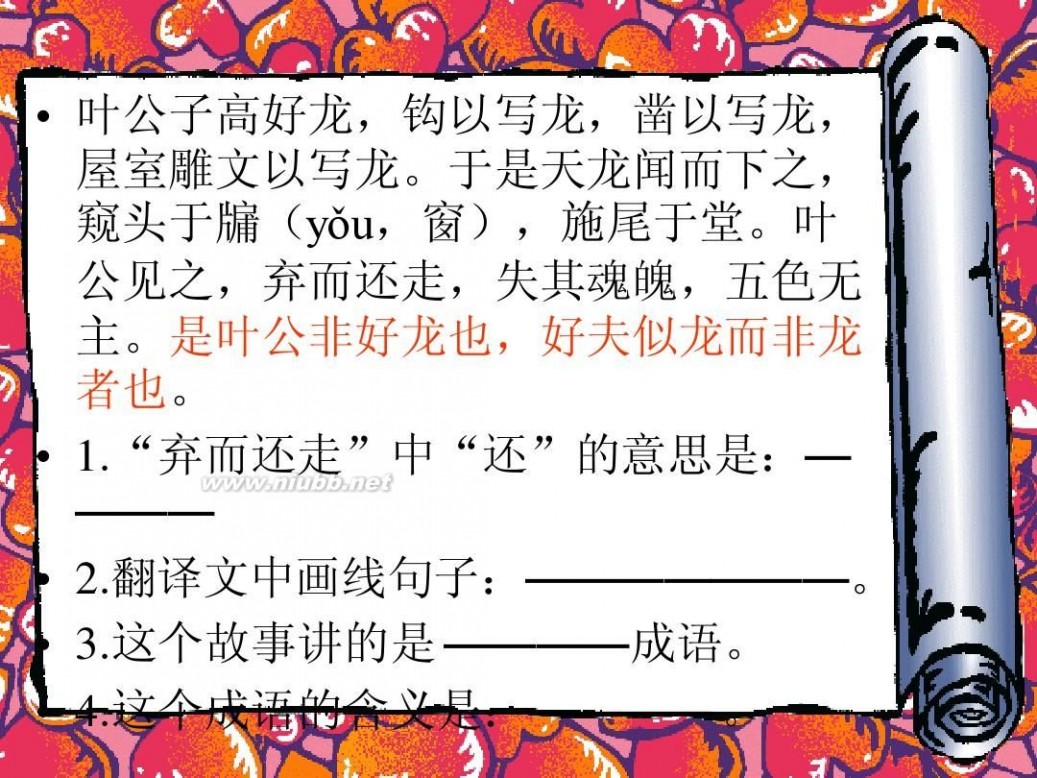
凿壁偷光文言文 复习六年级文言文阅读题和答案
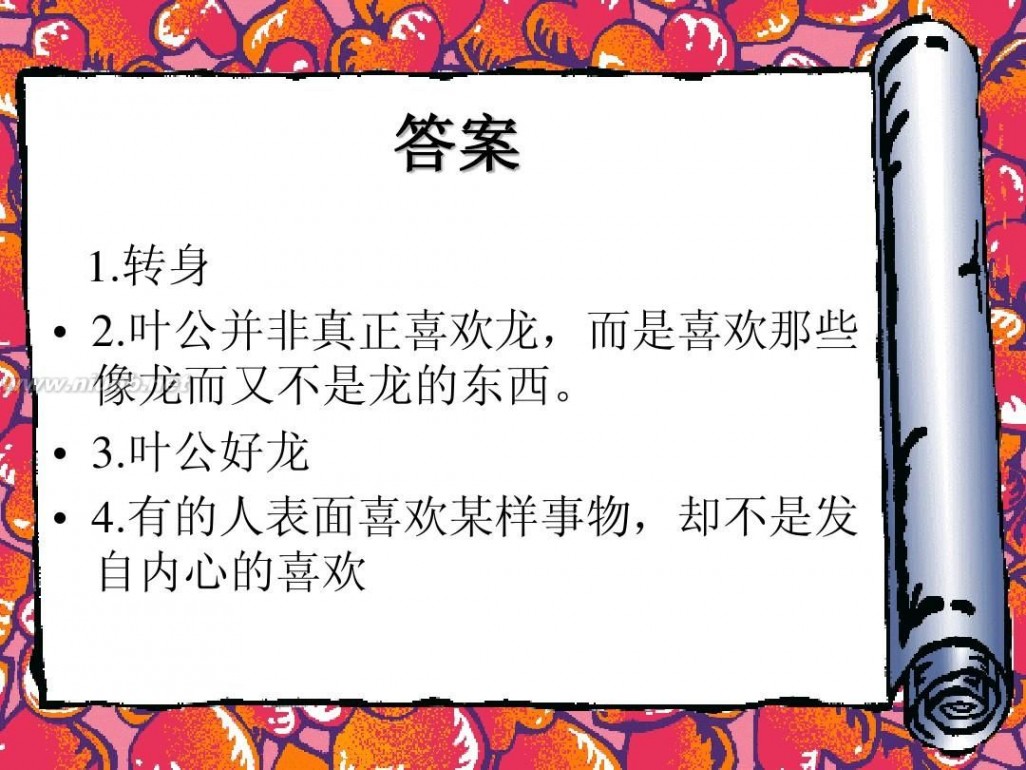
凿壁偷光文言文 复习六年级文言文阅读题和答案
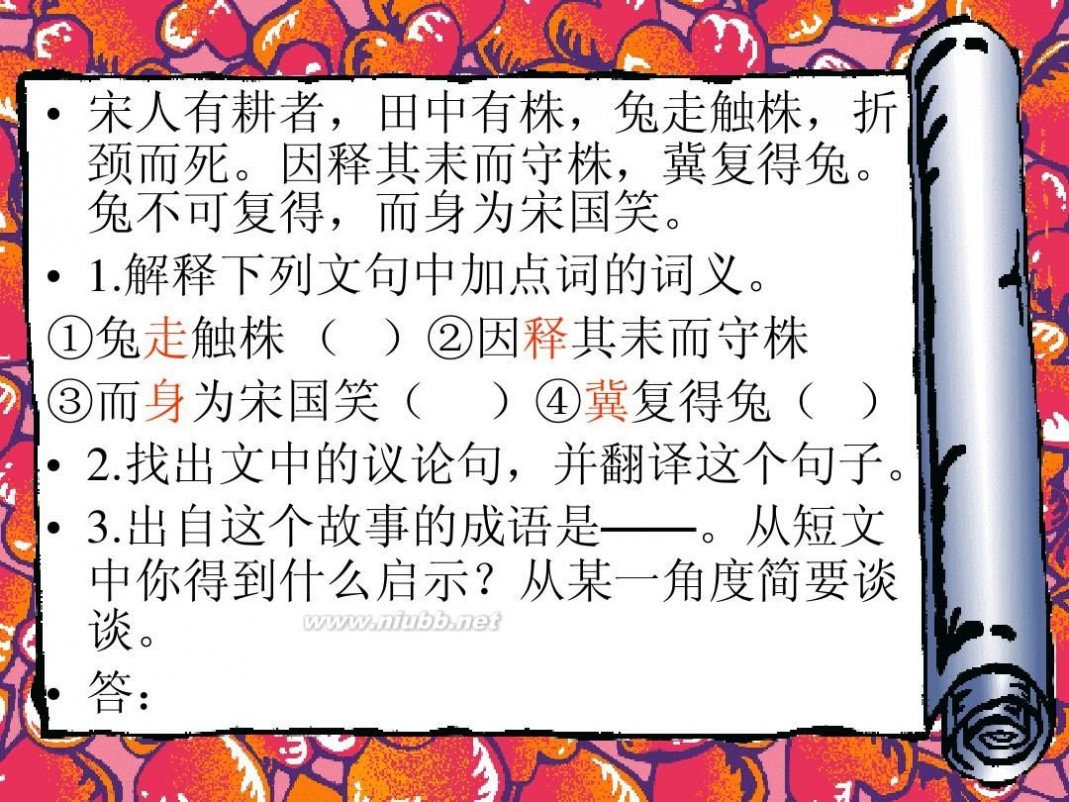
凿壁偷光文言文 复习六年级文言文阅读题和答案
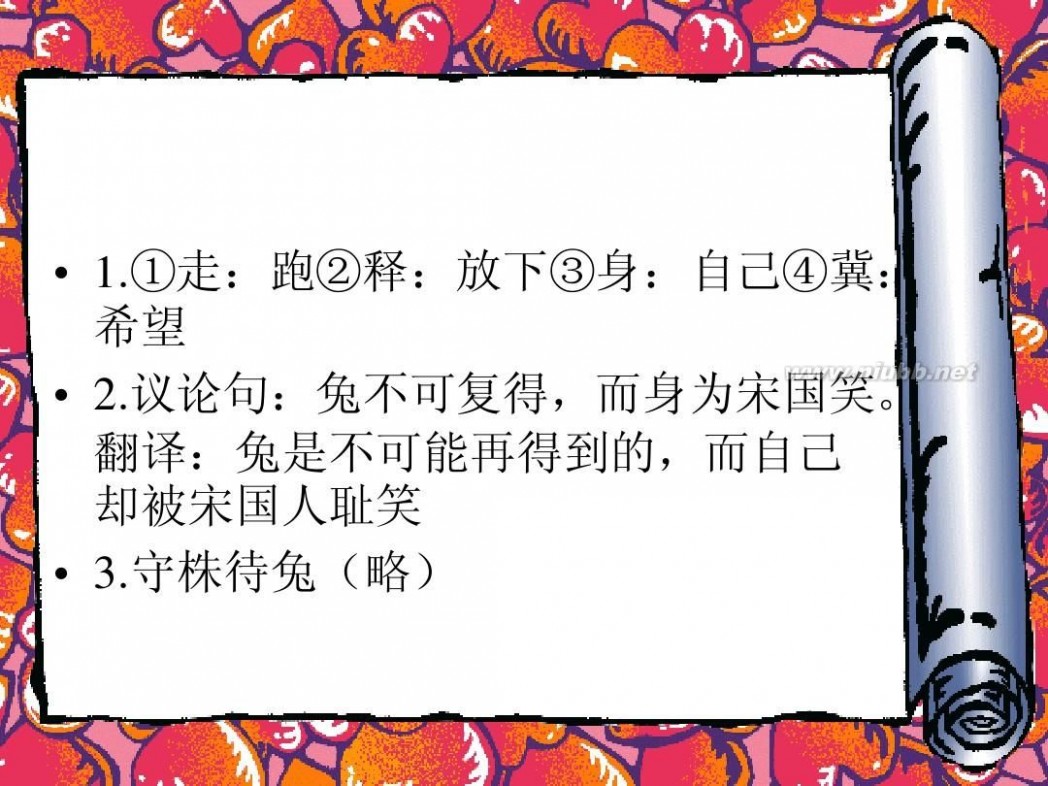
凿壁偷光文言文 复习六年级文言文阅读题和答案
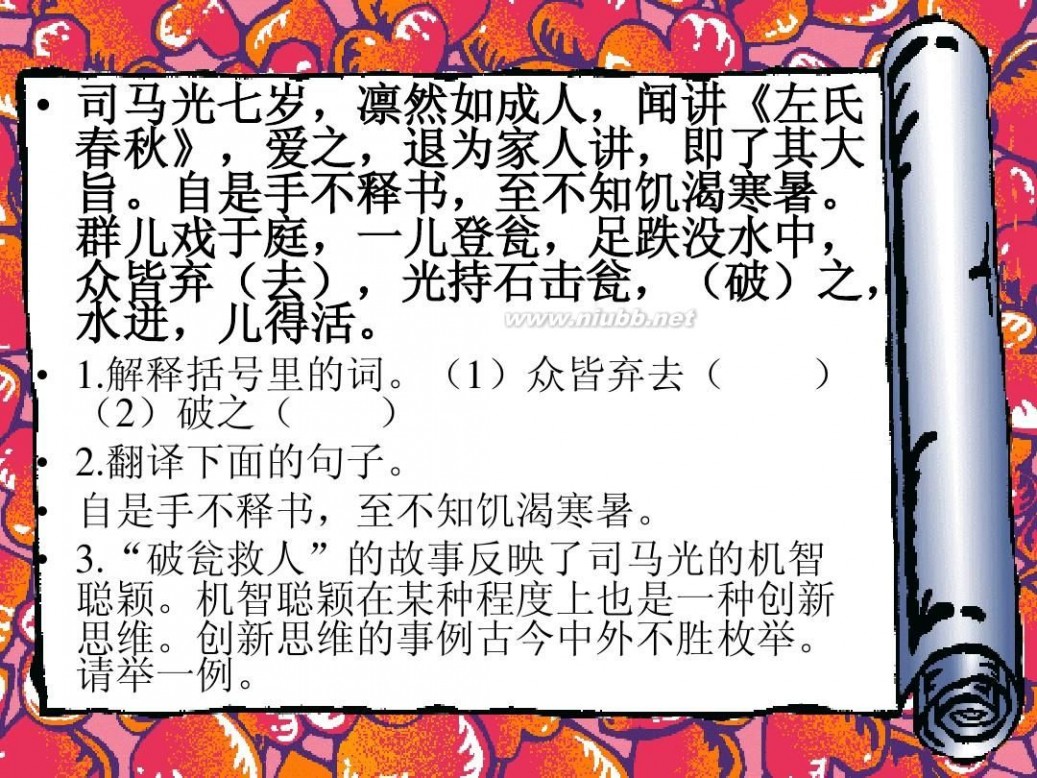
凿壁偷光文言文 复习六年级文言文阅读题和答案

凿壁偷光文言文 复习六年级文言文阅读题和答案

凿壁偷光文言文 复习六年级文言文阅读题和答案
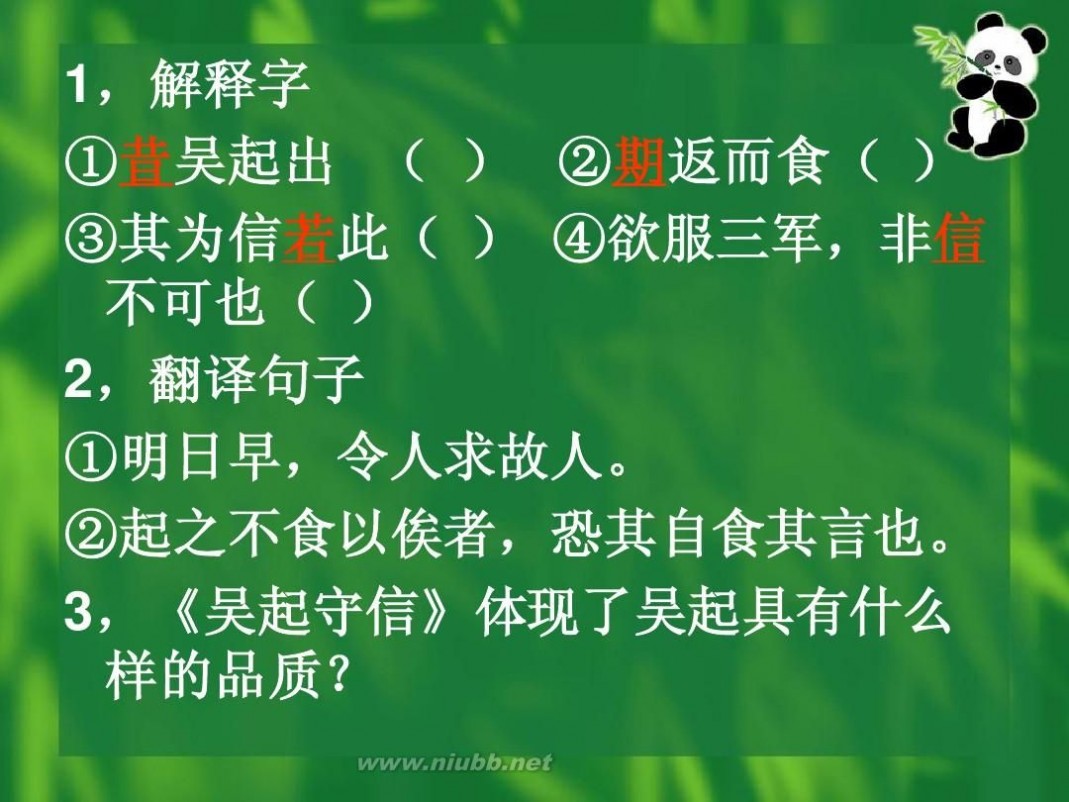
凿壁偷光文言文 复习六年级文言文阅读题和答案

凿壁偷光文言文 复习六年级文言文阅读题和答案
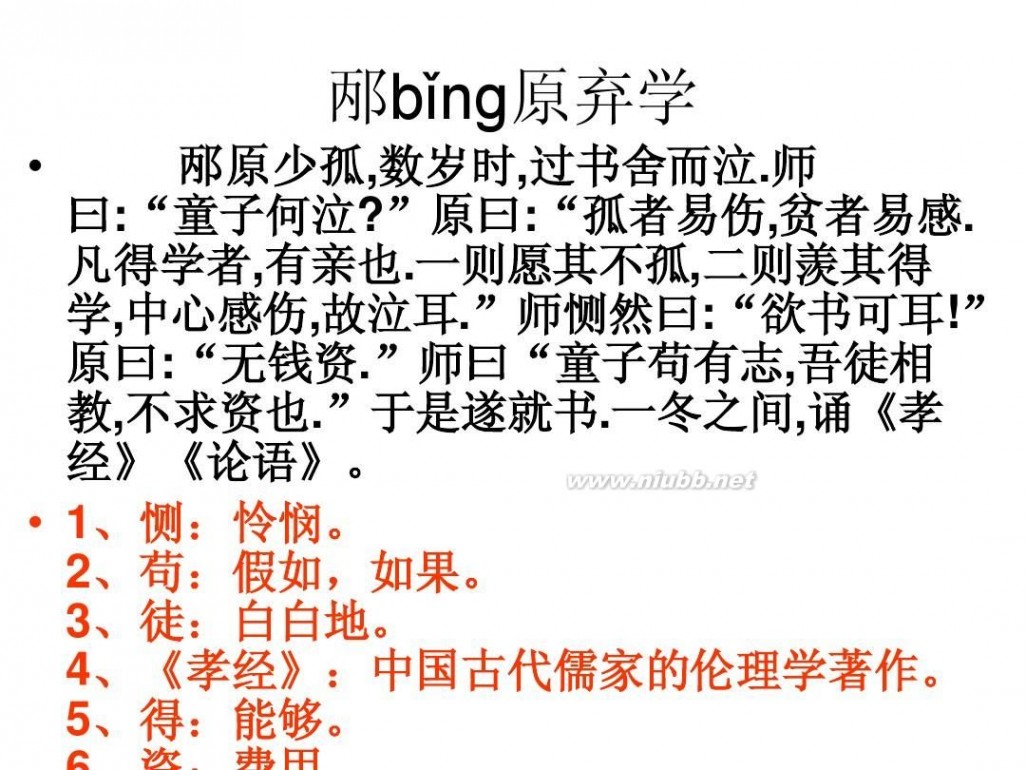
凿壁偷光文言文 复习六年级文言文阅读题和答案
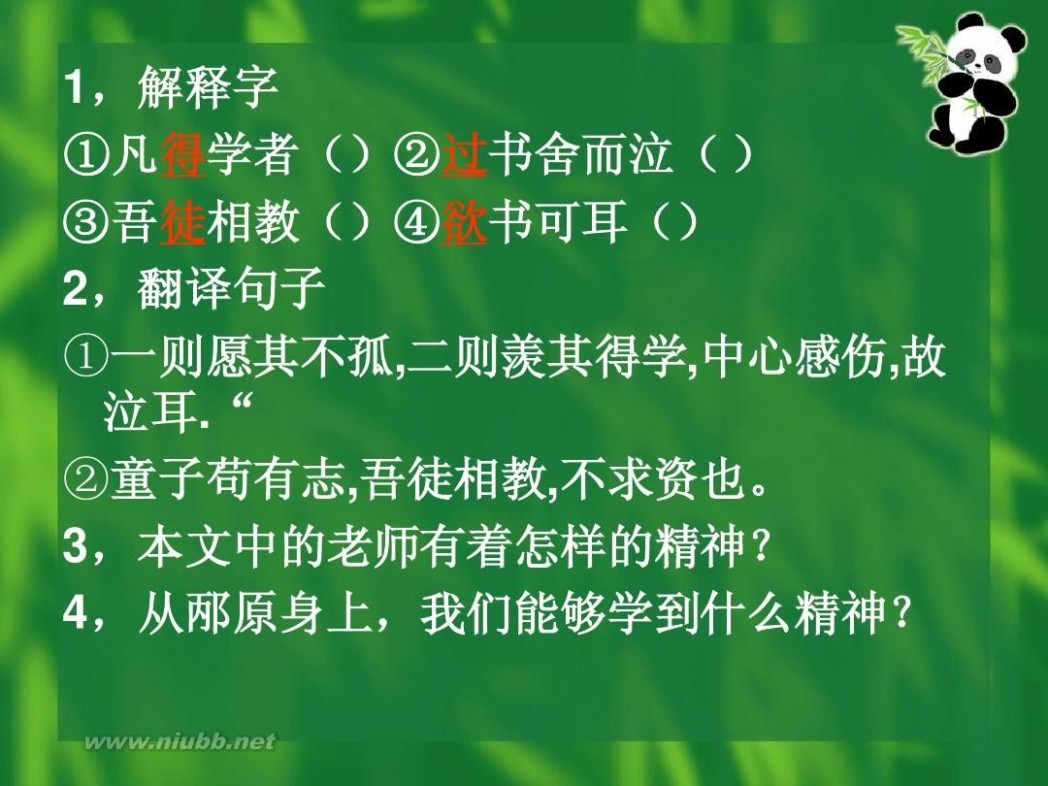
凿壁偷光文言文 复习六年级文言文阅读题和答案
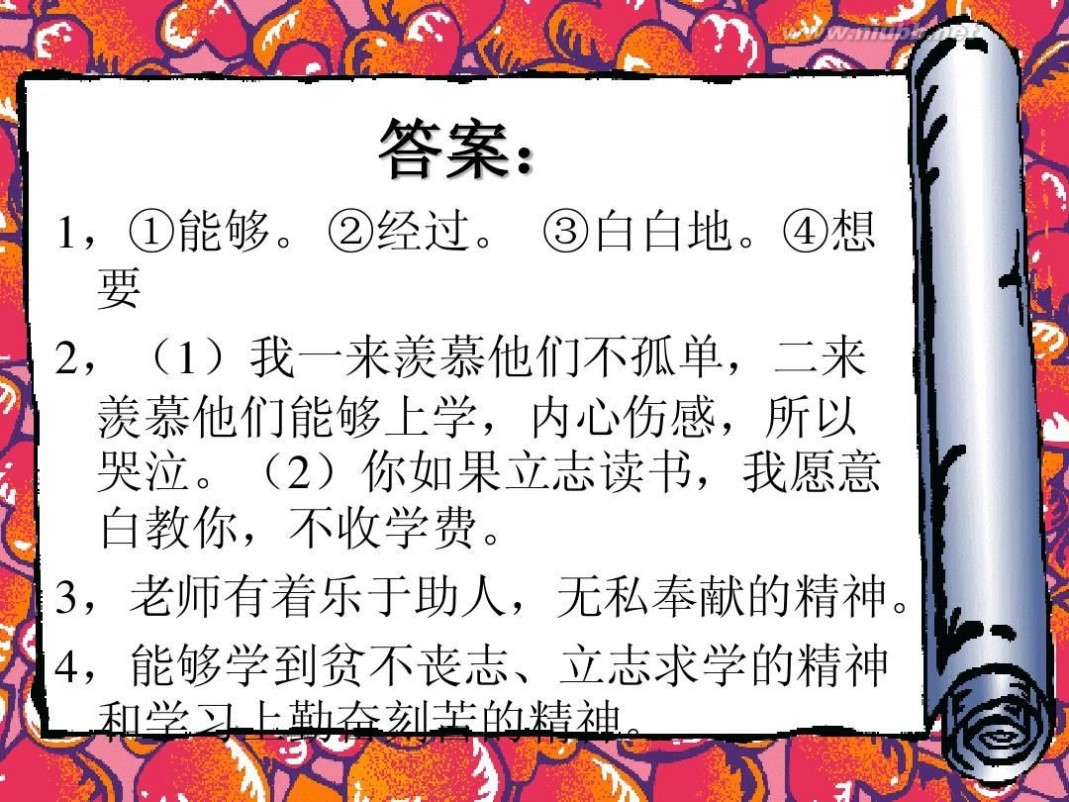
凿壁偷光文言文 复习六年级文言文阅读题和答案

凿壁偷光文言文 复习六年级文言文阅读题和答案
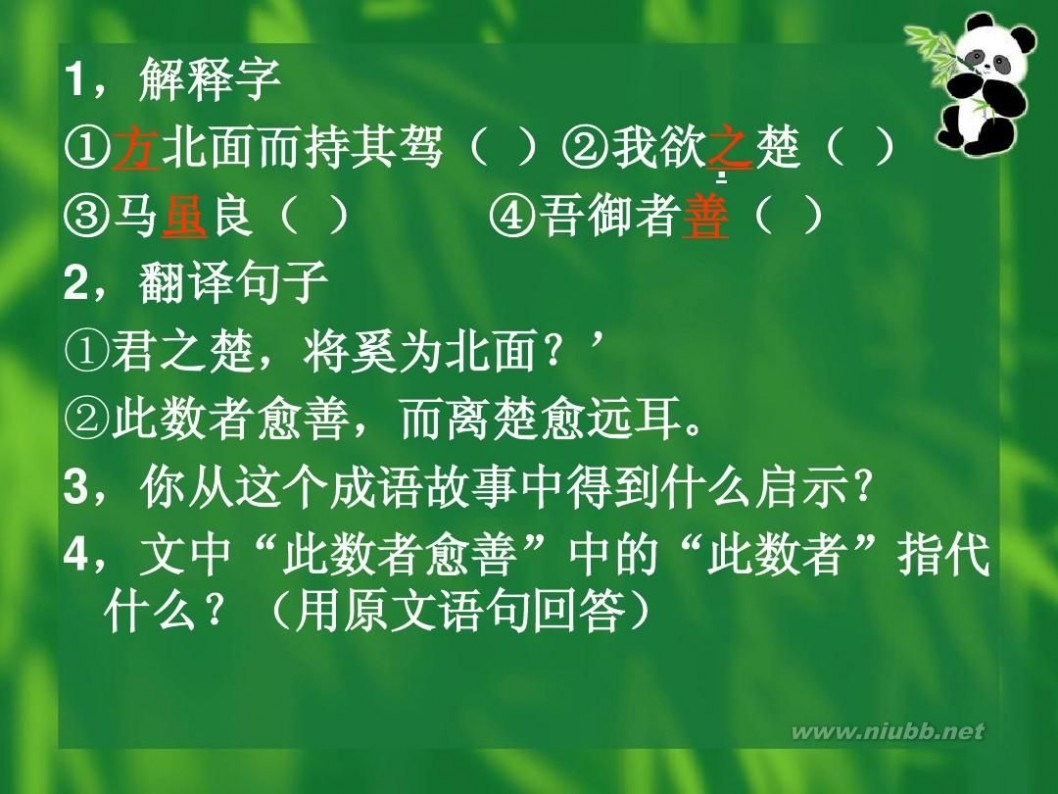
凿壁偷光文言文 复习六年级文言文阅读题和答案
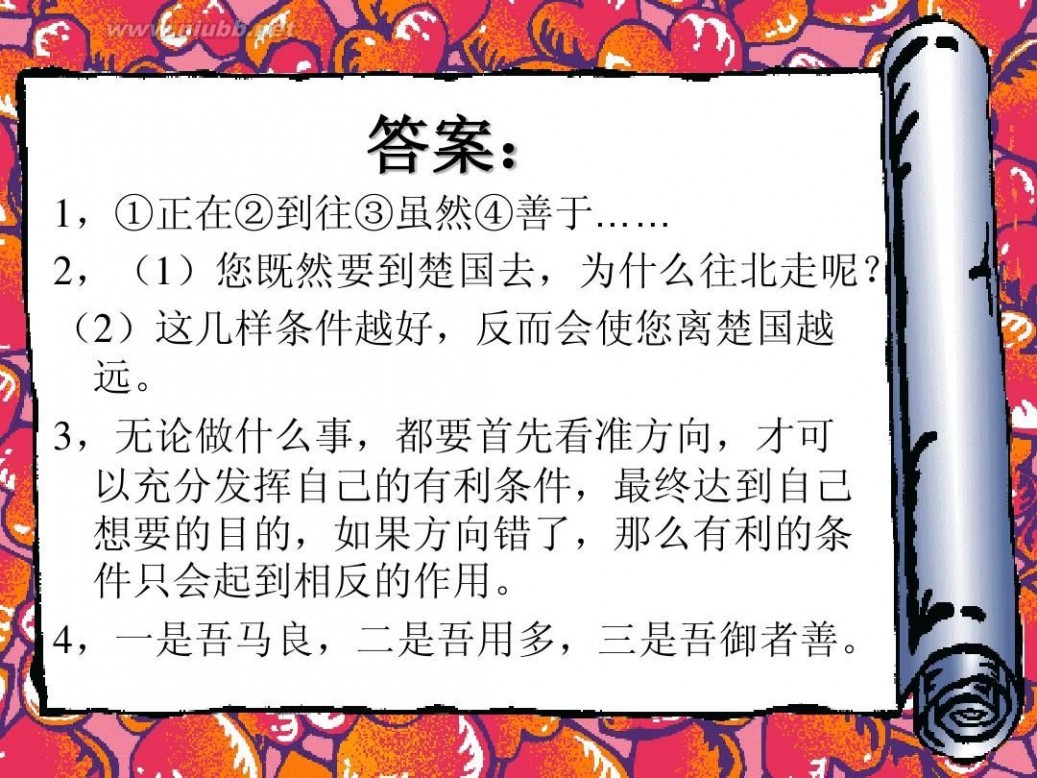
凿壁偷光文言文 复习六年级文言文阅读题和答案

凿壁偷光文言文 复习六年级文言文阅读题和答案
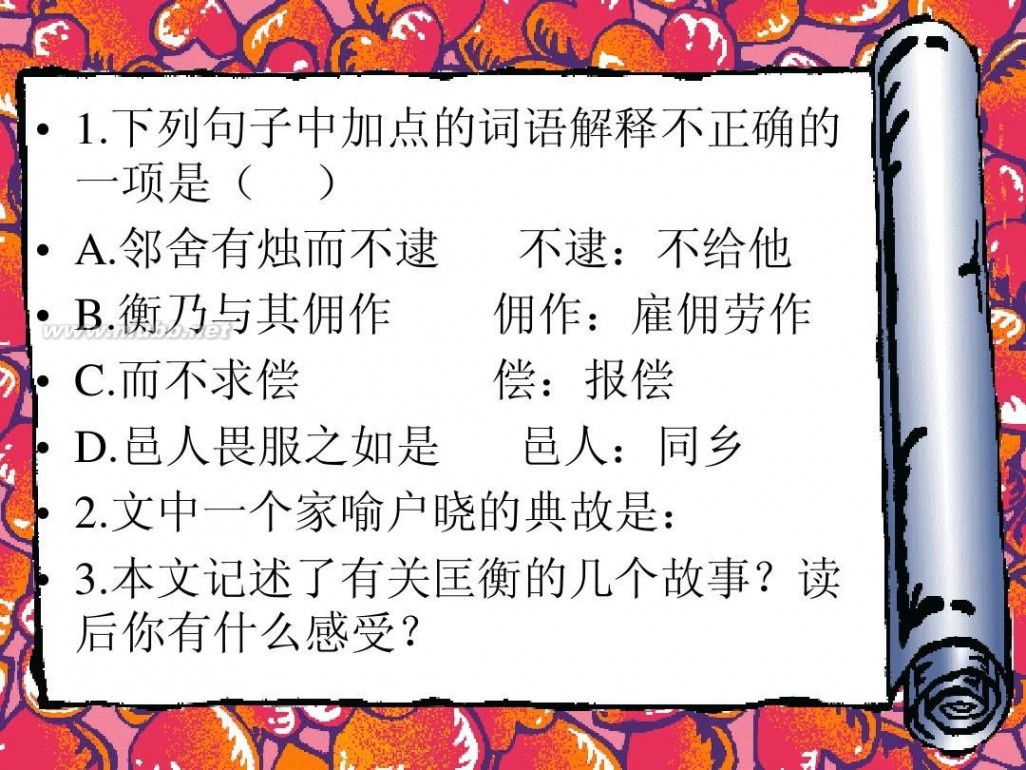
凿壁偷光文言文 复习六年级文言文阅读题和答案
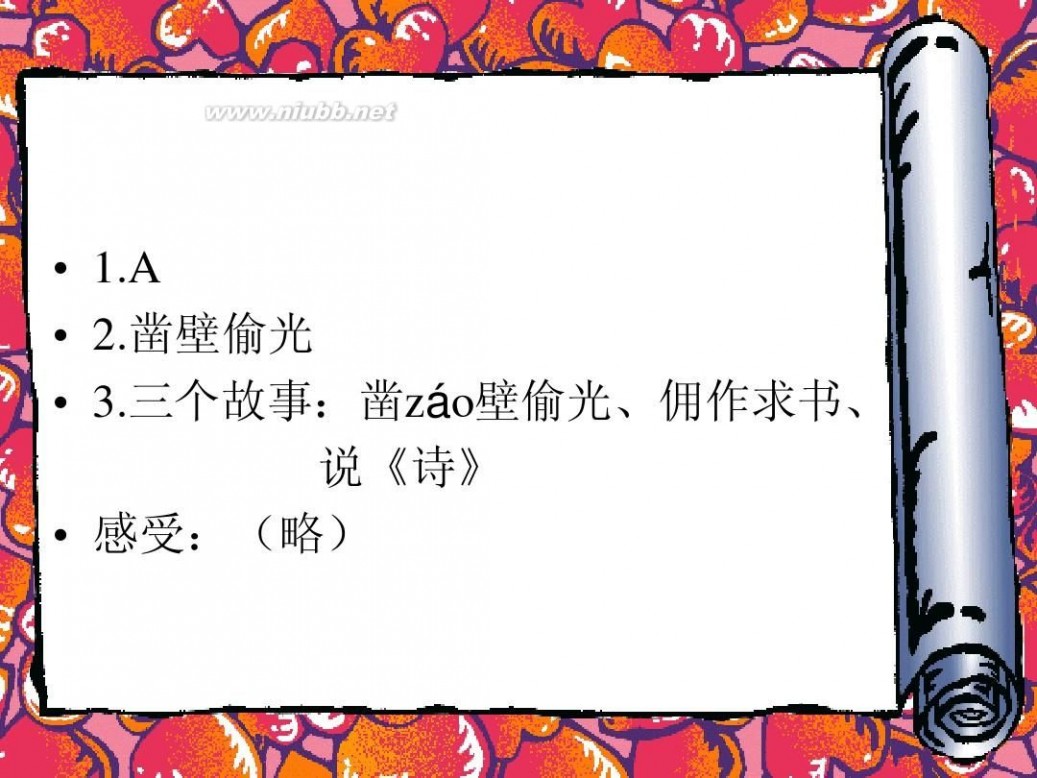
三 : 2014年12月六级阅读真题及答案
2014年12月六级阅读真题及答案
来源:文都教育
Part III Reading Comprehension (40 minutes)
Section A
Directions:In this section, there is a passage with ten blanks. You are required to select one word for each blank from a list of choices given in a word bank following the passage. Read the passage through carefully before making your choices. Each choice in the bank is identified by a letter. Please mark the corresponding letter for each item on Answer Sheet 2 with a single line through the centre. You may not use any of the words in the bank more than once.
Questions 36 to 45 are based on the following passage.
Children are natural-born scientists. They have 36 minds, and they aren’t afraid to admit they don’t know something. Most of them, 37 lose this as they get older. They become self-conscious and don’t want to appear stupid. Instead of finding things out for themselves they make 38 that often turn out to be wrong
So it’s not a case of getting kids interested in science. You just have to avoid killing the 39 for learning that they were born with. It’s no coincidence that kids start deserting science once it becomes formalized. Children naturally have a blurred approach to 40 knowledge. They see learning about science or biology or cooking as all part of the same act-it’s all learning. It’s only because of the practicalities of education that you have to start breaking down the curriculum into specialist subjects. You need to have specialist teachers who 41 what they know. Thus once they enter school, children begin to define subjects and erect boundaries that needn’t otherwise exist.
Dividing subjects into science, maths, English ,etc. is something we do for 42 . In the end it’s all learning, but many children today 43 themselves from a scientific education. They think science is for scientists, not for them.
Of course we need to specialize 44 . Each of us has only so much time on Earth, so we can’t study everything. At 5 years old, our field of knowledge and 45 is broad, covering anything from learning to walk to learning to count. Gradually it narrows down so that by the time we are 45, it might be one tiny little corner within science.
注意:此部分试题请在答题卡2上作答。[www.61k.com)
A A)accidentally
B)acquiring
C)assumptions
D)convenience
E)eventually
F)exclude
G)exertion
H)exploration
I)formulas
J)ignite
K)impart
L)inquiring
M)passion
N)provoking
O)unfortunately
【答案】
36. L 37. O 38. C 39.M 40.B 41. K 42. D 43.F 44.E 45. H
Section B
Directions: In this section, you are going to read a passage with ten statementsattached to it. Each statement contains information given in one of the paragraphs. Identify the paragraph from which the information is derived. You may choose a paragraph more than once. Each paragraph is marked with a letter. Answer the questions by marking the corresponding letter on Answer Sheet 2.
[A]For at least the last decade, the happiness craze has been building. In the last three months alone, over 1,000 books on happiness were released on Amazon, including Happy Money, Happy-People-Pills For All, and, for those just starting out, Happiness for Beginners.
[B]One of the consistent claims of books like these is that happiness is associated with all sorts of good life outcomes, including - most promisingly - good health. Many studies have noted the connection between a happy mind and a healthy body - the happier you are, the better health outcomes we seem to have. In a meta-analysis (overview) of 150 studies on this topic, researchers put it like this: “Inductions of well-being lead to healthy functioning, and inductions of ill-being lead to compromised health.”
[C]But a new study, just published in the Proceedings of the National Academy of Sciences (PNAS) challenges the rosy picture. Happiness may not be as good for the body as researchers thought. It might even be bad.
[D]Of course, it’s important to first define happiness. A few months ago, I wrote a piece called “There’s More to Life Than Being Happy” about a psychology study that dug into what happiness really means to people. It specifically explored the difference between a meaningful life and a happy life.
[E]It seems strange that there would be a difference at all. But the researchers, who looked at a large sample of people over a month-long period, found that happiness is associated with selfish “taking” behavior and that having a sense of meaning in life is associated with selfless “giving” behavior.
[F]“Happiness without meaning characterizes a relatively shallow, self-absorbed or even selfish life, in which things go well, needs and desire are easily satisfied, and difficult or taxing entanglements are avoided,”the authors of the study wrote. “If anything, pure happiness is linked to not helping others in need.” While being happy is about feeling good, meaning is derived from contributing to others or to society in a bigger way. As Roy Baumeister, one of the researchers, told me, “Partly what we do as human beings is to take care of others and contribute to others. This makes life meaningful but it does not necessarily make us happy.”
61阅读提醒您本文地址:
[G]The new PNAS study also sheds light on the difference between meaning and happiness, but on the biological level. Barbara Fredrickson, a psychological researcher who specializes in positive emotions at the University of North Carolina-Chapel Hill, and Steve Cole, a genetics and psychiatric researcher at UCLA, examined the self-reported levels of happiness and meaning in 80 research subjects.
[H]Happiness was defined, as in the earlier study, by feeling good. The researchers measured happiness by asking subjects questions like “How often did you feel happy?” “How often did you feel interested in life?” and “How often did you feel satisfied?” The more strongly people endorsed these measures of “hedonic well-being,” or pleasure, the higher they scored on happiness.
[I]Meaning was defined as an orientation to something bigger than the self. They measured meaning by asking questions like “How often did you feel that your life has a sense of direction or meaning to it?”, “How often did you feel that you had something to contribute to society?”, and “How often did you feel that you belonged to a community/social group?” The more people endorsed these measures of “eudaimonic well-being” - or, simply put, virtue - the more meaning they felt in life.
[J]After noting the sense of meaning and happiness that each subject had, Fredrickson and Cole, with their research colleagues, looked at the ways certain genes expressed themselves in each of the participants. Like neuroscientists who use fMRI scanning to determine how regions in the brain respond to different stimuli, Cole and Fredrickson are interested in how the body, at the genetic level, responds to feelings of happiness and meaning.
[K]Cole’s past work has linked various kinds of chronic adversity to a particular gene expression pattern. When people feel lonely, are grieving the loss of a loved one, or are struggling to make ends meet, their bodies go into threat mode. This triggers the activation of a stress-related gene pattern that has two features: an increase in the activity of proinflammatory genes and a decrease in the activity of genes involved in anti-viral responses.
[L]Cole and Fredrickson found that people who are happy but have little to no sense of meaning in their lives - proverbially, simply here for the party - have the same gene expression patterns as people who are responding to and enduring chronic adversity. That is, the bodies of these happy people are preparing them for bacterial threats by activating the pro-inflammatory response. Chronic inflammation is, of course, associated with major illnesses like heart disease and various cancers.
[M]“Empty positive emotions” - like the kind people experience during manic episodes or artificially induced euphoria from alcohol and drugs - ”are about as good for you for as adversity,” says Fredrickson.
[N]It’s important to understand that for many people, a sense of meaning and happiness in life overlap; many people score jointly high (or jointly low) on the happiness and meaning measures in the study. But for many others, there is a dissonance - they feel that they are low on happiness and high on meaning or that their lives are very high in happiness, but low in meaning. This last group, which has the gene expression pattern associated with adversity, formed a whopping 75 percent of study participants. Only one quarter of the study participants had what the researchers call “eudaimonic predominance” - that is, their sense of meaning outpaced their feelings of happiness.
[O]This is too bad given the more beneficial gene expression pattern associated with meaningfulness. People whose levels of happiness and meaning line up, and people who have a strong sense of meaning but are not necessarily happy, showed a deactivation of the adversity stress response. Their bodies were not preparing them for the bacterial infections that we get when we are alone or in trouble, but for the viral infections we get when surrounded by a lot of other people.
[P]Fredrickson’s past research, described in her two books, Positivity and Love 2.0, has mapped the benefits of positive emotions in individuals. She has found that positive emotions broaden a person’s perspective and buffers people against adversity. So it was surprising to her that hedonistic well-being, which is associated with positive emotions and pleasure, did so badly in this study compared with eudaimonic well-being.
[Q]“It’s not the amount of hedonic happiness that’s a problem,” Fredrickson tells me, “It’s that it’s not matched by eudaimonic well-being. It’s great when both are in step. But if you have more hedonic well-being than would be expected, that’s when this [gene] pattern that’s akin to adversity emerged.”
[R]The terms hedonism and eudemonism bring to mind the great philosophical debate, which has shaped Western civilization for over 2,000 years, about the nature of the good life. Does happiness lie in feeling good, as hedonists think, or in doing and being good, as Aristotle and his intellectual descendants, the virtue ethicists, think? From the evidence of this study, it seems that feeling good is not enough. People need meaning to thrive. In the words of Carl Jung, “The least of things with a meaning is worth more in life than the greatest of things without it.” Jung’s wisdom certainly seems to apply to our bodies, if not also to our hearts and our minds.
61阅读提醒您本文地址:
46. The author’s recent article examined how a meaningful life is different from a happy life.
47. It should be noted that many people feel their life is both happy and meaningful.
48. According to one survey, there is a close relationship between hedonic well-being measures and high scores on happy.
49.According to one of the authors of a new study, what makes life meaningful may not make people happy.
50.Experiments were carried out to determine our body’s genetic expression of feelings of happiness and meaning.
51. A new study claims happiness may not contribute to health.
52. According to researchers, taking makes for happiness while giving adds meaning to life.
53. Evidence from research shows that it takes meaning for people to thrive.
54. With regard to gene expression patterns, happy people with little or no sense of meaning in life are found to be similar to those suffering from chronic adversity.
55. Most books on happiness today assert that happiness is beneficial to health.
【答案】
46.D 47.N 48.H 49.F 50.J 51.C 52.E 53.R 54.L 55.B
Section C
Directions: There are 2 passages in this section. Each passage is followed by somequestions or unfinished statements. For each of them there are four choices marked A), B), C) and D). You should decide on the best choice and mark the corresponding letter on Answer Sheet 2 with a single line through the centre.
Passage 1
Nothing succeeds in business books like the study of success. The current business-book boom was launched in 1982 by Tom Peters and Robert Waterman with “In Search of Excellence”. It has been kept going ever since by a succession of gurus and would-be gurus who promise to distil the essence of excellence into three (or five or seven) simple rules.
“The Three Rules” is a self-conscious contribution to this type; it even includes a bibliography of “success studies”. MessrsRaynor and Mumtaz Ahmed work for a consultancy, Deloitte, that is determined to turn itself into more of a thought-leader and less a corporate repairman. They employ all the tricks of the success genre. They insist that their conclusions are “measurable and actionable”-guide to behavior rather than analysis for its own sake. Success authors usually serve up vivid stories about how exceptional business-people stamped their personalities on a company or rescued it from a life-threatening crisis. MessrsRaynor and Ahmed are happier chewing the numbers: they provide detailed appendices on “calculating the elements of advantage” and “detailed analysis”.
The authors spent five years studying the behaviour of their 344 “exceptional companies”, only to come up at first with nothing. Every hunch(直觉) led to a blind alley and every hypothesis to a dead end. It was only when they shifted their attention from how companies behave to how they think that they began to make sense of their voluminous material.
Management is all about making difficult tradeoffs in conditions that are always uncertain and ever-changing. But exceptional companies approach these trade-offs with two simple rules in mind, sometimes consciously, sometimes unconsciously. First: better before cheaper. Companies are more likely to succeed in the long run if they compete on quality or performance than on price. Second: revenue before cost. Companies have more to gain in the long run from driving up revenue than by driving down costs.
Most success studies suffer from two faults. There is “the halo (光环) effect”, whereby good performance leads commentators to attribute all manner of virtues to anything and everything the company does. These virtues then suddenly become vices when the company fails. MessrsRaynor and Ahmed work hard to avoid these mistakes by studying large bodies of data over several decades. But they end up embracing a different error: stating the obvious. Most businesspeople will not be surprised to learn that it is better to find a profitable niche (缝隙市场) and focus on boosting your revenues than to compete on price and cut your way to success. The difficult question is how to find that profitable niche and protect it. There, The Three Rules is less useful.
56.What kind of business books are most likely to sell well?
A)Books on excellence.C) Books on business rules.
B)Guides to management. D) Analyses of market trends.
57.What does the author imply about books on success so far?
A)They help businessmen on way or another.
B)They are written by well-recognised experts.
C)They more or less fall into the same stereotype.
D)They are based on analyses of corporate leaders.
58.How does The Three Rules different from other success books according to the passage?
A) It focuses on the behavior of exceptional businessmen.
B) It bases its detailed analysis on large amount of data.
C) It offers practicable advice to businessmen.
61阅读提醒您本文地址:
D) It draws conclusion from vivid examples.
What does the passage say contributes to the success of exceptional companies?
A)Focus on quality and revenue.
B) Management and sales promotion.
C) Lower production costs and competitive prices.
D) Emphasis on after-sale service and maintenance.
60 What is the author’s comment on The Three Rules?
A) It can help to locate profitable niches.
B) It has little to offer to businesspeople.
C) It is noted for its detailed data analysis.
D) It fails to identify the keys to success.
【答案】
56. A 57. C 58. D 59. A 60. B
Passage 2
Until recently, the University of Kent prided itself on its friendly image. Not anymore. Over the past few months it has been working hard, with the help of media consultants, to downplay its cosy reputation in favour of something more academic and serious.
Kent is not alone in considering an image revamp. Changes to next year’s funding regime are both forcing universities to justify charging students up to 9,000 in fees.
Nowadays, universities putting much more of a focus on their brands and what their value propositions are. While in the past universities have often focused on student social life and attractions of the university town in recruitment campaigns, they are now concentrating on more tangible attractions, such as employment prospects, engagement with industry, and lecturer contact hours, making clear exactly what students are going to get for their money.
The problem for universities is that if those benefits fail to materialise, students notice. That worries Rob Behrens, chief executive of the Office of the Independent Adjudicator (OIA), which deals with student complaints. “Universities need to be extremely careful that … they describe the reality of what’s going to happen to students,”he says. “Because competition is going to get greater for attracting students, there is a danger that universities will go the extra mile.”
One university told prospective engineering students they would be able to design a car and race it at Brands Hatch, which never happened, he says.“If universities spent as much money on handling complaints and appeals appropriately as they spend on marketing, they would do better at keeping students, and in the National Student Survey returns,”he says.
Ongoing research by Heist tracking prospective 2012 students suggests that they are not only becoming more sophisticated in thinking about what they want from a university, but are also spending more time researching evidence to back up institutional claims.
Hence the growing importance of the student survey and league tables. From next September, all institutions will also be expected to publish on their websites key information sets, allowing easier comparison between institutions - and between promises and reality - of student satisfaction levels, course information, and the types of jobs and salaries graduates go on to.
As a result, it is hardly surprising that universities are beginning to change the way they market themselves. While the best form of marketing for institutions is to be good at what they do, they also need to be clear about how they are different from others.
And it is vital that once an institution claims to be particularly good at something, it must live up to it. The moment you position yourself, you become exposed because you have played your joker, and if you fail in that you are in trouble.
61. What was the University of Kent famous for?
A. Its comfortable campus life.
B. Its up-to-date course offerings.
C. Its distinguished teaching staff.
D. Its diverse academic programs.
62. What are universities trying to do to attract students?
A. Improve their learning environment.
B. Upgrade their campus facilities.
C. Offer more scholarships to the gifted.
D. Present a better academic image.
63. What does Rob Behrens suggest universities do in marketing themselves?
A. Publicise the achievements of their graduates.
B. Go to extra lengths to cater to students’ needs.
C. Refrain from making promises they cannot honour.
D. Survey the expectations of their prospective students.
64. What is students’ chief consideration in choosing a university?
A. Whether it promises the best job prospects.
B. Whether it is able to deliver what they want.
C. Whether is ranks high among similar institutions.
D. Whether is offers opportunities for practical training.
65. What must universities show to win recruitment campaigns?
A. They are positioned to meet the future needs of society.
B. They are responsible to students for their growth.
C. They are ever ready to improve themselves.
D. They are unique one way or another.
【答案】61. A. 62. D 63. C 64. B 65. D
61阅读提醒您本文地址:
四 : 那年的江水 阅读题及答案
那年的江水
四年前,父亲因病去世,我听从母亲的安排,报考了师范。[www.61k.com]毕业后被分配到一所biān chuí(边陲)村小任教。
昔日的línɡ yún zhuànɡ zhì(凌云壮志)在fán suǒ(繁琐)的工作中被消磨得suǒ shènɡ wú jǐ(所剩无几 )。生活条件差,学生们不听话,领导的批评,让我倍感孤寂和怀才不遇。在这里,我找不到倾诉的对象,常一个人骑着自行车到不 远的江边去看浪花,因为只有浪花才能感受到我的无助和伤感。
那次是星期天,我没回家,蹬上自行车去看浪花。就是这一次,让我心头豁然一亮,影响了我的一生,甚至改变了我的一生。
从学校往北走,5分钟便到了江边。 江水生生不息地流淌了千百年,江边的泥沙便也日积月累地淤积了千百层,岸边便成了肥沃的土地。可很少有人来这江岸边kěn huānɡ(垦荒 )播种,倒不是人们粮仓里不缺这些米,口袋里不缺这些钱,而是因为每逢夏季,江水都有可能漫到岸边,把庄稼连根拔起,冲得无影无踪,让你起早贪黑白忙乎一场却颗粒无收。因此,江边总是静静的,只听得见浪花的喃喃细语。我放好自行车,慢慢地走在沙滩上。望海鸟飞过,看浪花逝去。我已习惯了这样。 我稍微抬了一下头,却看见不远处有一片地,禾苗长得枝粗叶大壮实无比, 油油的亮光灼得我眼痛,野草疯长得满地都是。
更令我感到惊讶的是,在烈日下,竟还有一位瘦矮的老农微屈着身子掘地锄草。我愣住了,看着那忙碌的背影发呆。 也不知过了多久,那位老农在一片空地上坐下来休息。我举目四望,岸滩不远处是一片葱葱茏茏的生机,习习江风不时让这醉人的绿摇着头,或欢笑或歌唱。而空气中也氤氲yīn yūn(弥漫)着江水、泥沙和草儿的清香,偶有一艘机帆船向蓝天深处驶去。昔日对这一切感到窒闷的我竟被感染得出了些生气来。
我带着满脑的疑惑同老农聊开了。我不解地问:“您在这里种庄稼,水涨上来了咋办,那不是白忙活了一年吗?”
那年的江水 那年的江水 阅读题及答案
老农听后,嘿嘿地笑着说:“谁知道今年水会不会涨上来?我也没去想。(www.61k.com]你想想看,你要有收成就必须流汗,可流汗了不一定有收成。今年淹了,说不定明年不会淹,希望总是有的嘛!” 听完老农这番平凡朴实而饱含深厚哲理的话,我脑中像点燃了一团火,像拨亮了一盏灯,让我对前方不再感到迷惑。以前,我总认为我努力工作了一定会得到成绩;我付出了,一定会得到回报。看来,我想错了。 老农的话让我明白了对学生的爱得无条件地付出。 那天,天蓝,云白,心爽。我悠悠地骑着自行车唱着歌儿回到了学校。
之后,讲台上是我深入浅出的讲解,下课时教室里是我悉心辅导的身影。夜晚,星星作伴,我睡得很晚,月亮作证,我起得很早。 江水那年并没有漫上岸滩,老农的庄稼获得了好收成,而我在人生路上也迈出了坚实的一步。
1、近义词:哲理( 道理 ) 悉心( 细心 )
反义词:孤寂( 热闹 ) 坚实( 软弱 )
2、看拼音,在( )里填汉字。
3、联系上下文解释“怀才不遇” 胸怀才学但生不逢时,难以施展;不被赏识任用。
2、划横线的这句话表达 “我” 孤独 寂寞 无助的心情。
3、短文用 一团火和 一盏灯 比喻那位老农的话对我的启迪。
4、老农为什么在经常被水淹的江边垦荒播种? 因为要有收成就必须流汗,可流汗了不一定有收成。今年淹了,说不定明年不会淹,希望总是有的嘛!
5、概括短文主要内容。

五 : 六年级阅读题以及答案
生之喜悦
美国西海岸的边境城市圣迭(di?)戈的一家医院里,长年住着因外伤全身瘫(tān)痪(huàn)的威廉·马修。(www.61k.com)当阳光从朝南的窗口射入病房时,马修开始迎接来自身体不同部位的痛楚的袭击——病痛总是早上光临。在将近一个小时的折磨中,马修不能翻身,不能擦汗,甚至不能流泪,他的泪腺(xiàn)由于药物的副作用而萎缩。
年轻的女护士为马修所经受的痛苦以手掩面,不敢正视。马修说:“钻心的刺痛难忍,但我还是感激它——痛楚让我感到我还活着。”
马修住院的头几年,身体没有任何感觉,没有舒适感也没有痛楚感。在医生的精心治疗下,有一部分神经已经再生,每天早上向中枢(shū)神经发出“痛”的信号。
在痛楚中发现喜悦,这在一般人看来简直是荒唐。但置身马修的处境,就知道这种特定的痛楚不仅给他带来了喜悦,而且带来了希望。当然一个重要前提在于,马修是一个意志坚强的人。
过去马修经历过无数没有任何知觉的日夜。如果说,痛楚感是一处断壁残垣(yuán)的话,无知觉则是死寂的沙漠。痛楚感使马修体验到了“存在”。从某种意义上说,这甚至是一种价值体现——医疗价值与康复价值的体现。当然,马修不是病态的自虐(nua)狂,他把痛楚作为契(qì)机,进而康复,享受到正常人享有的所有感受。谁也不能保证可怜的马修能获得这一天,但他和医生一起朝这个方向努力,因而他盼望痛楚会在第二天早晨如期到来。
1、破折号的主要用法有①表注释,②表语意转换,③表声音延长或中断。请判断下面句子中破折号的用法,选择序号填在句子后面的( )中。(2分)
A.当阳光从朝南的窗口射入病房时,马修开始迎接来自身体不同部位痛楚的袭击——病痛总是早上光临。( )
B.钻心的刺痛难忍,但我还是感激它——痛楚让我感到我还活着。 ( )
22分)
3、在短文中找出表现马修所经受的痛苦的句子,选两句摘抄下来。(2分)
A、
B、
4、马修为什么要感激使他钻心难忍的痛楚?(3分)
5、读了短文后,你有什么感受?请用简洁流畅的语言写下来。(3分)
六年级阅读题及答案 六年级阅读题以及答案
《生之喜悦》答案
1、破折号的主要用法有①表注释,②表语意转换,③表声音延长或中断。[www.61k.com)请判断下面句子中破折号的用法,选择序号填在句子后面的( )中。(2分)
A.当阳光从朝南的窗口射入病房时,马修开始迎接来自身体不同部位痛楚的袭击——病痛总是早上光临。(①)
B.钻心的刺痛难忍,但我还是感激它——痛楚让我感到我还活着。 (①)
2、你对“生之喜悦”这个题目的理解:只有活着,才是最宝贵的(2分)
3、在短文中找出表现马修所经受的痛苦的句子,选两句摘抄下来。(2分)
A.在将近一个小时的折磨中,马修不能翻身,不能擦汗,甚至不能流泪,他的泪腺由于药物的副作用而萎缩。
B. 马修说:“钻心的刺痛难忍,但我还是感激它——痛楚让我感到我还活着。”
4、马修为什么要感激使他钻心难忍的痛楚?(3分)
因为他把痛楚作为契机,进而康复,享受到正常人享有的所有感受。
5、读了短文后,你有什么感受?请用简洁流畅的语言写下来。(3分) 只要你活着,比什么都珍贵,一定要好好珍惜时光,不要浪费时间。
六年级阅读题及答案 六年级阅读题以及答案
心中有景
南山下有一座庙,庙里有一株古榕树。[www.61k.com)
一天清晨,小和尚起来洒扫庭院,见古榕树下落叶满地,不禁忧从中来,望树兴叹。
忧至极处,便丢下扫把奔至师父的堂前,叩门求见。
师父闻声开门,见徒弟愁容满面,以为发生了什么事,急忙询问:“徒儿,大清早为何
事如此忧愁?”
小和尚满腹疑惑的说:“师父,你日夜劝导我们要勤于修身悟道,可是,即使我学得再
好,人难免有死亡的一天。到那时候,所谓的我,所谓的道,不正如秋天的落叶、冬天的枯
枝一样,被一堆黄土所掩埋吗?”
老和尚听后,指着古榕树对小和尚说:“徒儿,不必为此忧虑。其实,秋天落叶和冬天
的枯枝,在秋风刮得最急的时候,在冬雪落得最密的时候,它们都悄悄地爬回了树上,开成
了春天的花,长成了夏天的叶。”
“我怎么没看见呢?”
“那是因为你心中无景,所以看不见花开。”
面对落叶凋零而去憧憬含苞待放,这需要一颗不朽的春心,一颗乐观的心。
人的一生难免会遇到一些不幸,在你不备的时候打击你,但是我们没有必要为了等待这
一天的到来而整日忧心忡忡,自己跟自己过不去。
以乐观的态度对待人生,不仅可以化解烦恼与不幸,而且每天都会有一种愉快的心情让
自己的生命鲜活起来。
只要心中有景,何处不是花香满径。
6、小和尚见落叶满地,不禁“忧从中来”、“愁容满面”,他为什么“忧愁”?请用自己的话
概括回答。(2分)
答:
7、老和尚为什么没有小和尚的“忧愁”?他是怎样面对生活、对待人生的?(4分)
答:
8、“秋天落叶和冬天的枯枝,在秋风刮得最急的时候,在冬雪落得最密的时候,它们都悄悄
地爬回了树上,开成了春天的花,长成了夏天的叶。”老和尚这番含有哲理的话,不由得使
我们想起近代著名思想家龚自珍《己亥杂诗》中赞美“落花精神”的两句诗:“
” (2分)
9、结合全文,仔细体会划线句子的意思,说说“鲜活”一词的具体含义。(2分)
答:
10、读了此文,你认为“心中有景”的真正含义是什么?对你有何启迪?(4分)
答:
六年级阅读题及答案 六年级阅读题以及答案
6、小和尚有树叶凋零想到人难免一死,对生命存在的意义产生了疑惑,故而“忧愁”。(www.61k.com]
7、因为老和尚有一颗“不朽的春心”,他从秋叶凋零、冬枝残落“看”到了春花开放、夏叶生长,对未来充满希望,所以他没有小和尚的“忧愁”;他是以一种乐观而积极的态度面对生活、对待人生的。
8、落红不是无情物,化作春泥更护花。
9、“鲜活”指富有生机与活力,即让生命更充实、更有意义、更有价值。
10“心中有景”指以乐观而积极的态度面对生活、对待人生的,对未来充满希望和憧憬,围绕“启迪”来谈。
本文标题:六年级阅读题及答案-七年级语文《世说新语 咏雪》阅读题及答案61阅读| 精彩专题| 最新文章| 热门文章| 苏ICP备13036349号-1